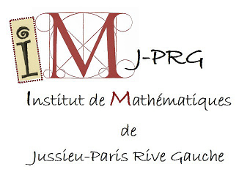| Responsables : | A. Brochier, O. Brunat, J.-Y. Charbonnel, O. Dudas, E. Letellier, D. Juteau, M. Varagnolo, E. Vasserot |
| Email des responsables : | Adrien Brochier <adrien.brochier@imj-prg.fr>, Olivier Brunat <olivier.brunat@imj-prg.fr>, Jean-Yves Charbonnel <jean-yves.charbonnel@imj-prg.fr>, Olivier Dudas <olivier.dudas@imj-prg.fr>, Emmanuel Letellier <emmanuel.letellier@imj-prg.fr>, Daniel Juteau <daniel.juteau@imj-prg.fr>, Michela Varagnolo <varagnol@math.u-cergy.fr>, Eric Vasserot <eric.vasserot@imj-prg.fr> |

